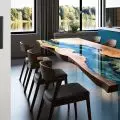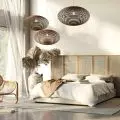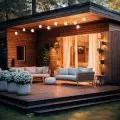An intimate building in Warsaw's Praga district, which would house dwellings for artisans practicing often-forgotten professions, apartments for creative artists and communal areas integrating tenants with local residents, was proposed by architects from the MFRMGR studio. The designers dressed the inspiring assumptions in a simple but extremely thoughtful wooden prefabricated structure.
unique location
Warsaw's Praga district has its own special atmosphere, preserved urban layout and scale of development. As noted by architects from the MFRMGR studio, the district has largely resisted the bad development practices of the 1990s and 2000s, whose gated neighborhoods and the pursuit of every extra meter destroyed the character of the old quarters. In recent years, a number of measures have been taken to restore the neighborhood's splendor - a revitalization program, renovation of vacant buildings or adaptation of post-factory areas.
We wanted to draw attention to the fact that the climate and history of this place - old Prague - is also smaller, modest buildings, for example, old blacksmith shops, shoe factories or rental houses. [...] Constructed, among other things, of wood, such as Burke's Wooden House," write architects from the MFRMGR office.



mockup photo
© MFRMGR Architects
Wooden F25 infill
A team of architects from the Warsaw office of MFRMGR proposed an unusual building on one of Praga's plots - a wooden infill, a six-story residential and commercial building, which is to integrate users and residents with the local community. Inside, seven residential units were planned, to be temporarily occupied by artists and researchers, lovers of this unique neighborhood creating a platform for interaction and exchange of views in the space of the building, and three service units intended for craftsmen practicing today's disappearing professions who would like to pass on their skills to the next generation. In the building, an important role is also played by integrative zones where residents could meet - on the top floor a common terrace overgrown with greenery has been planned, and on level -1 - a space illuminated by natural light for various activities and space for café tables.



visualization of the building
© MFRMGR Architects
This project commissioned by a private investor could have looked polite and staid. The façade would have been made of brick reminiscent of unplastered factory buildings, and the function would have been typically commercial - that is, the sale of "trendy" micro-apartments in a "loft-like" atmosphere. As conscious designers, we saw the potential of this plot and proposed a building that would serve a slightly different function. It would be both an intimate residential building with services, but functioning a little differently," the designers explain.
wooden structure
The unusual function is inscribed in an equally unusual for buildings of this scale structure. According to the design, both the structure of the building and its facades are to be made of wood. Almost the entire structure would be made of wooden prefabricated elements, while the first floor, level -1, elevator shaft and staircase would be made of reinforced concrete.
axonometry
© MFRMGR Architects
The modules of the residential units with all the necessary installations and equipment are to be prefabricated independently elsewhere and placed in the building, so that no time is wasted on detailed finishing of the units. By this we assume that the time provided for the entire construction will be reduced to a minimum -- the project authors add.
The facade is to be finished with properly protected panels of glued, waterproof plywood in a natural gray color. A space has been planned for a mural on the top blind wall, which, according to the designers' plans, would change with the successive tenants of F25.
the gable wall intended for the mural
© MFRMGR Architects
Ola Kloc: You write that with the F25 project you wanted to recall the heritage of building wooden buildings in Warsaw's Praga district. Which ones were the biggest inspiration for you?
Marta Frejda and Michal Gratkowski: As Varsovians and residents of the capital city, over the years we have observed changes and degradation of various spaces. Improperly maintained, unprotected and poor development of countless plots of land in the city is disappearing, making room for the "new better."
As an office, we took part in social projects both at the Przyjaźń Estate (wooden buildings) in Bemowo, co-creating one of the projects of the Urban Sports Square initiative, and explored the issues of Jazdów, where, in addition to urban planning, an intact fabric of wooden buildings has survived. But these were post-war buildings. Now we are designing several architectural assumptions in the area of Otwock and Jozefow, where wooden architecture is something natural.
In this particular case in the Praga district, which inspires us, we were captivated by the uneven fight against time, including Burke's Wood, a building that is just now being duly preserved.... and we decided to take up this theme in our project.
Ola: What is the main idea behind this project?
Marta and Michal: The project has several important ideas. First of all, it is a wooden seal, embedded in tradition. Outside of Prague, it is difficult to erect new buildings of this type in Warsaw. The second is that it is a building that gives something to the local community, and is not just a well-known store with an amphibian in its logo, but a place that interacts with its surroundings. It encourages local patriotism and emphasizes the quality of local services. Where both artisan and customer know and respect each other.
development and first floor plan
© MFRMGR Architects
Ola: How do you think wood can be used on a larger scale in buildings larger than single-family homes?
Marta and Michal: There are many ways. It seems to us that a good model is Scandinavia, where I think even recently a big furniture company started to produce residential buildings from wood. In our opinion, it would be good for this to go hand in hand with prefabrication. And awareness of where that wood comes from. It is important to remember that prefabricating components is cheaper and easier than using concrete, for example. By the way, the carbon footprint of such construction is smaller. But we don't know if turning the whole machine around at a moment's notice just to build larger-scale structures out of wood wouldn't also be detrimental....
Ola: According to your assumption, F25 is supposed to foster the integration of the local community with the future residents of the district, how do you think architecture can help in such activities?
Marta and Michal: Residential buildings with services are, in a way, public facilities in the city, so they should be accessible to local residents to some extent. The integration of acreage in this building is multi-faceted - starting withthe façade with a temporary mural that influences the viewer. Similarly, friendly, non-obvious services that are not just businesses, but are also educational, allowing for workshops, for example. You can also carve out spaces that are friendly to some degree, such as the kinds of patios, pocket parks.... This affects the neighbors' perception of the architecture. The building itself, assuming that future users will be interested in research and relations in Prague, creates the status of a place where such integration is advisable.
schematic cross-section
© MFRMGR Architects
Ola: Your approach from inhabiting the F25 building is also interesting - it would be occupied by artists whose fruits of labor would be available to all. Tell us more about this idea.
Marta and Michal: In a way, that's what we would like to do. But it's a jet open formula - it's important that someone has an idea of what they would like to do. This is where the exchange of ideas and experiences should take place. But this is not a building just for artists. They can be sociologists, writers.... For example, if someone collects data on signboards and moves out after a while, the result of his work can always be published online. We have seen similar working ideas in Berlin, for example.
Ola: Thank you for the interview!





































































